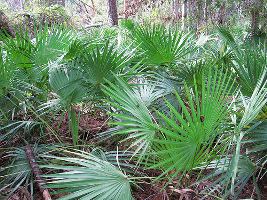In traditional and modern medicine, an extract from the fruit of Serenoa repens is used to treat prostrate swelling, baldness, and urinary tract infections. Other uses are as a fiber for basketry and thatch. It is a slow-growing and long-lived plant, with some specimens as old as 500 to 700 years old. The genus name is in honor of American botanist Sereno Watson. Saw palmetto is native to the U.S. and is in the Arecaceae (palm) family.
Photo Credit: Karan A. Rawlins, University of Georgia, Bugwood.org
Serenoa repens
Common Name: saw palmetto
Plant Functional Group: Evergreen broadleaf
Class > Order > Family: Magnoliopsida > Arecales > Arecaceae
What does the species look like?
Serenoa repens is a perennial shrub or small tree 10 to 12 feet in height. Its trunk grows in clumps or dense thickets. The silvery-green to yellow-green, fan-shaped leaves with sharp teeth or spines give the species its common name, saw palmetto. The flowers are fragrant and yellowish-white and are pollinated by bees. The fruit is an orangish-black drupe.
Saw palmetto grows best in warm-temperate or humid, subtropical climates. It grows well in sun but is tolerant to shade. It is often found as understory in pinelands, hardwood hammocks and woodlands, sand dunes, sand pine scrub, and savannas. Although it is a high water user, saw palmetto grows best in dry, well-drained soils rather than water-logged soils
The palmetto skipper caterpillar feeds exclusively on the plant; its fruits are eaten by black bear, white-tailed deer, raccoons, foxes, opossums, tortoise, and birds. Saw palmetto also provides shelter and nesting for burrowing owls and sandhill cranes.
Where is the species found?
States & Provinces
AK, FL, GA, LA, MS, SC, TX
Special Considerations for Observing
If drought seems to be the cause of leaf color or fall for a plant, please make a comment about it for that observation.
Which phenophases should I observe?
Do you see...?
Flowers
Flowers or flower buds More...
How many flowers and flower buds are present? For species in which individual flowers are clustered in flower heads, spikes or catkins (inflorescences), simply estimate the number of flower heads, spikes or catkins and not the number of individual flowers.
Less than 3 3 to 10 11 to 100 101 to 1,000 1,001 to 10,000 More than 10,000
Open flowers More...
What percentage of all fresh flowers (buds plus unopened plus open) on the plant are open? For species in which individual flowers are clustered in flower heads, spikes or catkins (inflorescences), estimate the percentage of all individual flowers that are open.
Less than 5% 5-24% 25-49% 50-74% 75-94% 95% or more
Fruits
Fruits Serenoa repens , the fruit is fleshy and berry-like and changes from yellowish-green to orangish to blue-black.More...
How many fruits are present?
Less than 3 3 to 10 11 to 100 101 to 1,000 1,001 to 10,000 More than 10,000
Ripe fruits Serenoa repens , a fruit is considered ripe when it has turned blue-black.More...
What percentage of all fruits (unripe plus ripe) on the plant are ripe?
Less than 5% 5-24% 25-49% 50-74% 75-94% 95% or more
Recent fruit or seed drop More...
How many mature fruits have dropped seeds or have completely dropped or been removed from the plant since your last visit?
Less than 3 3 to 10 11 to 100 101 to 1,000 1,001 to 10,000 More than 10,000
What do these phenophases look like?
There is currently no photoguide available for this species. If you'd like help us create one, use the guidance document and species template provided here . Then send it via email to education@usanpn.org when it is complete.
